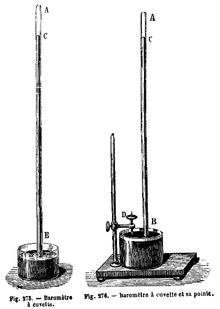Evangelista Torricelli
Evangelista Torricelli (Faenza, Italy, October 15, 1608-Florence, Italy, October 25, 1647) was an Italian physicist who invented the mercury barometer and showed that he could have a container without content when extracting the air.
Early years of life
His parents did not have much money, instead they were very fond of him, they called him Evangelista, and seeing the potential that Torricelli had, they decided to send him to his uncle Jacopo, a Camaldolese friar, who educated him under his tutelage. In 1627 he was sent to Rome to study science with the Benedictine Benedetto Castelli (1579-1645), called by Urban VII to teach mathematics at the College of Sapienza and one of the first disciples of Galileo.
He studied one of Galileo Galilei's works, Discorsi e dimostrazioni matematiche, intorno a due nuove scienze (Discourse and mathematical demonstration, about two new sciences, 1638), which inspired him to develop some of the mechanical principles established there, which he collected in his work De motu. In 1632, Castelli contacted Galileo to show him the work of his pupil and ask him to take him in, a proposal that Galileo accepted, so Torricelli moved to Arcetri, where he served as Galileo's amanuensis for the last three months of his life. of the Italian sage, who passed away early the following year. After Galileo's death, Torricelli, who wanted to return to Rome, yielded to Ferdinand II de' Medici's offers and, appointed philosopher and mathematician to the Grand Duke and professor of mathematics at the Florence Academy, settled permanently in this city.
Scientific papers.
In 1643, Torricelli used mercury by making it rise in a closed tube, creating a vacuum at the top, pushed by the weight of the air in the atmosphere. He proved that air has weight, and he invented the barometer. The unit of pressure torr was named in his memory. Torricelli's theorem is an application of Bernoulli's principle and studies the flow of a liquid contained in a container, through a small hole, under the action of gravity. He published his work on the movement under the title Geometric Opera. The publication, together with this work, of various works on the properties of cycloid curves led to a bitter dispute with Roberval, who accused him of plagiarizing his solutions to the problem of squaring these curves. Although there seems to be no doubt that Torricelli arrived at the same result independently, the debate over the scoop of the solution lasted until his death.
- Vt=2⋅ ⋅ g⋅ ⋅ (h+v022⋅ ⋅ g){displaystyle V_{t}={sqrt {2cdot gcdot left(h+{frac {v_{0}{2}}{2cdot g}}}}}{2cdot g}}}}}}}}}}
Among the discoveries he made is the principle that if a series of bodies are connected in such a way that, due to their motion, their center of gravity cannot rise or fall, then these bodies are in equilibrium. He further discovered that the envelope of all parabolic trajectories described by projectiles launched from a point with the same velocity, but in different directions, is a paraboloid of revolution. Likewise, he used and perfected Cavalieri's method of indivisibles.
He also made important improvements to the telescope and microscope, with numerous lenses manufactured by him and engraved with his name that are still preserved in Florence.
Death
Torricelli died at the age of 39 in Florence on October 25, 1647, a few days after contracting typhoid fever. He was buried in the Basilica of San Lorenzo. He left all his belongings to his adoptive son, Alessandro Di Almagro.
Eponymy
- The pressure unit called torr is a tribute to his last name.
- The lunar crater Torricelli carries this name in his memory.
- The asteroid (7437) Torricelli also commemorates its name.

